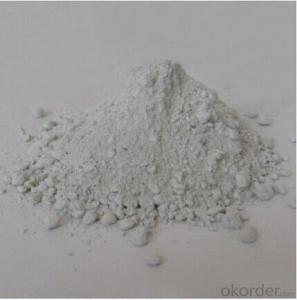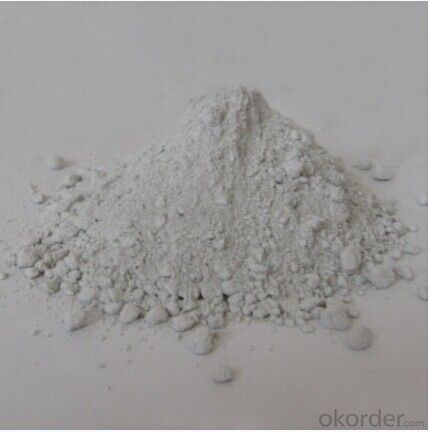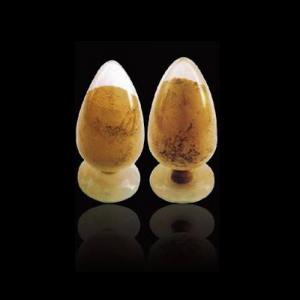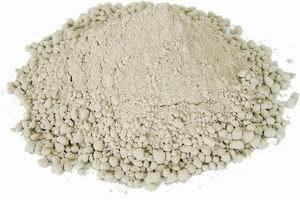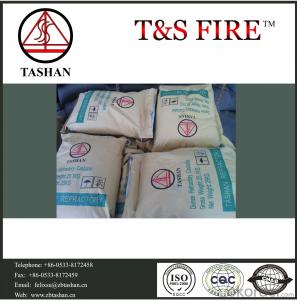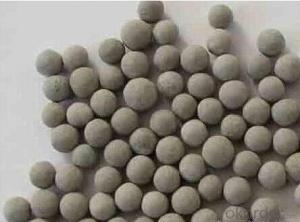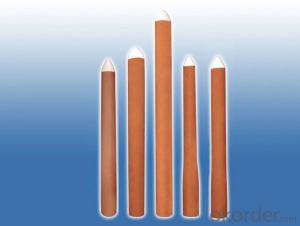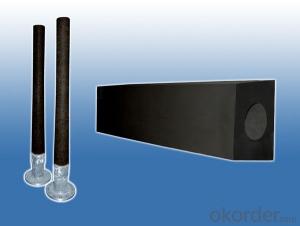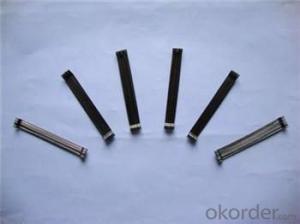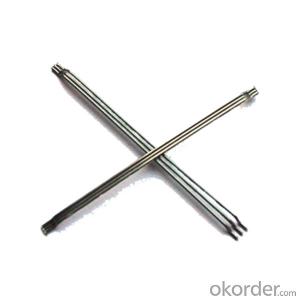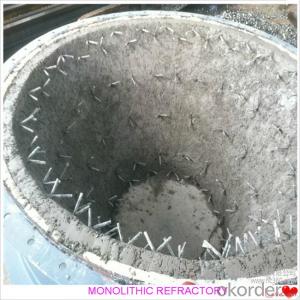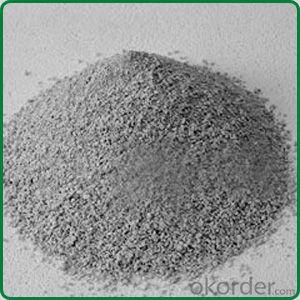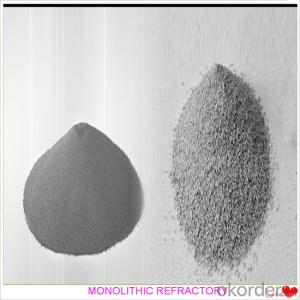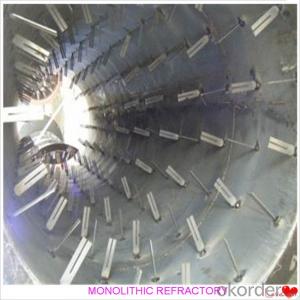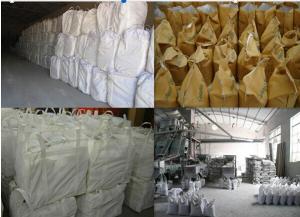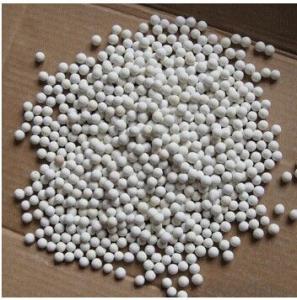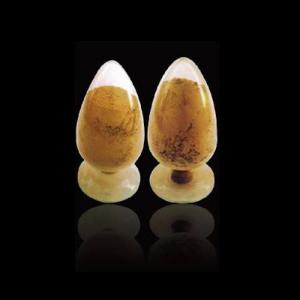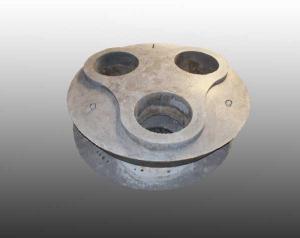Monolithic Refractories for Iron and Steel Industry - Castable Refractory for Cement Kiln and Boiler
- Loading Port:
- China Main Port
- Payment Terms:
- TT OR LC
- Min Order Qty:
- -
- Supply Capability:
- -
OKorder Service Pledge
OKorder Financial Service
You Might Also Like
Benefits:
1) Good performance to thermal stability, slag and abrasion resistance.
2) Good fluidity and convenient to install and maintain
3) Less installation and drying/sintering time
4) Efficiently reduced the production stoppages & downtimes
5) Labor and cost saving by prolonging campaign length.
| Refractory Castable for cement kiln | | | | |
| Items | HGJ-1 | HAJ-3 | HAM-2 | HAL-2 |
| Main Contents | Al2O3 | Al2O3 | MgO-Al2O3 | Al2O3-SiO2 |
| Characteristics | High strength anti-abrasion steel fiber castables | Chemical-bonding refractory castables | Low cement magnesium-aluminum castables | high purity bauxite low cement |
| Refractoriness | 1950℃ | 2150℃ | 2150℃ | 1700℃ |
| Density | 2.95g/cm3 | 2.89g/cm3 | 2.92g/cm3 | 2.55g/cm3 |
| Compressive Strength | 110℃×2h68.5MPa; | 110℃×2h59.2MPa; | 110℃×2h40.8MPa; | 110℃×2h52MPa |
| | 1500℃×3h 96.8 MPa | 1500℃×3h106.1MPa | 1500℃×3h102.5MPa | 1500 ℃×3h 75 MPa |
| Permanent Linear Changing Rate | 1500℃×3h+0.21% | 1500℃×3h+0.29% | 1500℃×3h+0.32% | 1500℃×3h±0.5% |
| Installation mode | casting | casting | casting | casting |
| Additive required | 5-10%water | 5-10%water | 5-10%water | 5-10%water |
| Application | Rotary kiln or industry furnace | Industry kiln | Ladle | differentpartsforcementkiln |
characteristics:
1. The dosage of cement is low, the content of calcium only accounts for 1/4-1/3 of common Refractory Castable
2. Wter consumption rate during the construction is almost 1/2 or 1/3 of the common Refractory Castable, so the Low Cement Refractory Castable has high density and low porosity.
3. High normal temperature cure property, intensity will be increased after medium temperature and high temperature. Three or five times more than common Refractory Castable.
4. Good volume stability under high temperature.
Application:
Material for metallurgy, petroleum, chemical and other industries kilns
Part of refining installation, like ladle cover
Insert for roof of the kiln
- Q: What are the recent developments in monolithic refractories for the iron and steel industry?
- In recent years, there have been several significant developments in monolithic refractories for the iron and steel industry. Monolithic refractories play a crucial role in the production of iron and steel, as they provide high-temperature resistance and insulation to the lining of furnaces and other equipment used in the industry. One of the key advancements in monolithic refractories is the development of advanced alumina-based castables. These castables offer superior thermal shock resistance, high strength, and excellent corrosion resistance, making them ideal for use in the iron and steel industry. They can withstand extreme temperatures and mechanical stresses, ensuring longer service life and reduced downtime for maintenance. Another notable development is the introduction of low-cement and ultra-low cement castables. These castables have a reduced cement content compared to traditional castables, resulting in improved refractory properties. They offer higher hot strength, reduced porosity, and enhanced resistance to slag and metal corrosion. This allows for increased productivity and efficiency in iron and steel manufacturing processes. Furthermore, there have been advancements in the use of insulating refractories in the iron and steel industry. Insulating castables and bricks are now being used to line ladles, tundishes, and other equipment, providing better insulation and energy efficiency. These materials help to reduce heat loss and improve thermal efficiency, resulting in cost savings and reduced environmental impact. Additionally, the development of monolithic refractories with improved installation techniques has been a significant development. Traditional brick lining methods require skilled labor and a longer installation time. However, with the introduction of gunning and shotcreting techniques, the installation process has become faster and more efficient. These techniques involve spraying refractory materials onto the lining surface, ensuring better adherence and reducing the risk of lining failure. Overall, the recent developments in monolithic refractories for the iron and steel industry have focused on improving thermal shock resistance, corrosion resistance, insulation properties, and installation techniques. These advancements have resulted in increased efficiency, reduced downtime, and improved productivity in the iron and steel manufacturing processes.
- Q: How do monolithic refractories perform in aluminum holding furnace applications?
- Monolithic refractories perform exceptionally well in aluminum holding furnace applications due to their high thermal conductivity, excellent resistance to thermal shock, and superior mechanical strength. They can withstand the extreme temperatures and harsh chemical environments found in these furnaces, ensuring long-lasting and efficient operations. Additionally, monolithic refractories offer easy installation and maintenance, making them a preferred choice in aluminum holding furnace applications.
- Q: Can monolithic refractories be used in electric arc furnaces and induction furnaces?
- Yes, monolithic refractories can be used in both electric arc furnaces and induction furnaces. Monolithic refractories are versatile and can be shaped and installed easily, making them suitable for various types of furnaces, including electric arc furnaces and induction furnaces. These refractories are composed of a single material, such as castables, gunning mixes, ramming mixes, and plastic refractories, which can withstand high temperatures and thermal shock. They are commonly used to line the walls, roofs, and bottoms of furnaces to provide insulation and protection against the extreme heat generated during the melting and refining processes. Monolithic refractories offer excellent resistance to chemical attack, erosion, and mechanical stress, making them ideal for use in electric arc furnaces and induction furnaces, where intense heat and harsh operating conditions are encountered.
- Q: What are the main types of monolithic refractories used in the iron and steel industry?
- The main types of monolithic refractories used in the iron and steel industry are castables, ramming materials, gunning materials, and plastic refractories. Castables are a type of refractory material that can be poured or cast into various shapes and sizes. They are made from a mixture of refractory aggregates, binders, and additives. Castables are commonly used in areas such as ladles, tundishes, and blast furnaces due to their excellent thermal shock resistance and high strength. Ramming materials, also known as ramming mixes, are used for lining the bottoms of furnaces and other high-temperature applications. They are typically composed of refractory aggregates and a bonding agent, which allows them to be compacted or rammed into place. Ramming materials offer good resistance to thermal cycling and can withstand high temperatures. Gunning materials are designed to be sprayed or gunned onto the refractory surface using a high-pressure gunning machine. They are used for repairing and patching refractory linings that have been damaged or eroded. Gunning materials are usually made from a mixture of refractory aggregates, binders, and additives. They provide excellent adhesion and are commonly used in applications such as kilns, converters, and electric arc furnaces. Plastic refractories are a type of monolithic refractory that can be molded or formed into various shapes. They are made from a mixture of refractory aggregates, plasticizers, and binders. Plastic refractories are used for lining various equipment and structures in the iron and steel industry, including boilers, incinerators, and chimneys. They offer good resistance to thermal shock and can be easily installed by hand or with a trowel. Overall, these types of monolithic refractories play a crucial role in the iron and steel industry by providing high-temperature resistance, thermal insulation, and durability to the various equipment and structures used in the production process.
- Q: How do monolithic refractories contribute to the efficiency of iron and steel production?
- Monolithic refractories play a critical role in improving the efficiency of iron and steel production processes. These refractories are renowned for their superior thermal properties, high resistance to mechanical stress, and outstanding resistance to chemical corrosion. One primary manner in which monolithic refractories enhance the efficiency of iron and steel production is by providing effective insulation. By lining furnaces and other high-temperature equipment, monolithic refractories prevent heat loss and ensure consistent maintenance of desired temperatures. This insulation helps reduce energy consumption by minimizing heat wastage, ultimately resulting in cost savings. Moreover, monolithic refractories offer exceptional resistance to thermal shock. In the iron and steel industry, frequent heating and cooling cycles are common, and conventional refractory materials may crack or fail under these conditions. However, monolithic refractories can endure rapid temperature fluctuations without failure, guaranteeing the longevity and reliability of the refractory lining. This resistance to thermal shock reduces downtime for repairs and maintenance, thereby increasing overall production efficiency. Furthermore, monolithic refractories exhibit significant resistance to chemical corrosion. In iron and steel production, various corrosive substances such as molten metal, slag, and gases are present. By utilizing monolithic refractories as lining materials, the underlying structures are protected from chemical attack, preventing erosion and prolonging the equipment's service life. This corrosion resistance reduces the need for frequent repairs or replacements, leading to cost savings and enhanced productivity. Additionally, monolithic refractories offer easy installation and repair. Unlike traditional refractories, which are often constructed brick by brick, monolithic refractories are applied as a single mass. This allows for faster installation and reduces the potential for weak points or joints that may compromise the overall efficiency of the refractory lining. Furthermore, when repairs or maintenance are necessary, monolithic refractories can be easily patched or replaced, minimizing downtime and ensuring seamless operation. To summarize, the use of monolithic refractories in iron and steel production contributes to increased efficiency in multiple ways. Their outstanding thermal insulation properties reduce energy consumption, while their resistance to thermal shock and chemical corrosion ensures reliable and long-lasting refractory linings. Additionally, their easy installation and repair capabilities further enhance productivity. Overall, monolithic refractories are an indispensable component in improving the efficiency and sustainability of iron and steel production processes.
- Q: How do monolithic refractories improve the efficiency of ladle and tundish purging furnaces?
- There are several ways in which monolithic refractories play a crucial role in enhancing the efficiency of ladle and tundish purging furnaces. To begin with, monolithic refractories possess outstanding thermal insulation properties, enabling them to retain heat within the furnace and minimize heat loss to the surroundings. This results in the furnaces being able to operate at higher temperatures, leading to improved efficiency. The higher temperatures facilitate better steel refining, faster heating and purging of the ladle and tundish, and overall increased productivity. Furthermore, monolithic refractories offer superior resistance to thermal shock. The continuous flow of molten metal in purging furnaces, particularly in ladles and tundishes, subjects the refractories to rapid heating and cooling cycles. Traditional refractories may crack or fail under such thermal cycling, resulting in reduced efficiency and additional downtime for repairs. However, monolithic refractories can withstand these extreme temperature changes, ensuring uninterrupted operation and minimizing the need for frequent maintenance. In addition, monolithic refractories exhibit excellent resistance to chemical attacks from molten metals and slag. During the purging process, ladles and tundishes come into contact with aggressive materials that can erode the refractory lining. Monolithic refractories are specifically designed to endure these harsh environments, preventing erosion and prolonging the lifespan of the furnaces. This resistance to chemical attacks not only enhances efficiency by minimizing refractory wear but also guarantees the production of high-quality steel with reduced impurities. Lastly, monolithic refractories offer great versatility in terms of installation and repair. Unlike traditional refractories that necessitate complex bricklaying techniques, monolithic refractories can be easily shaped and installed, enabling faster and more efficient lining construction. Additionally, monolithic refractories can be effortlessly repaired or patched, reducing downtime and ensuring continuous operation of the furnace. In conclusion, monolithic refractories significantly enhance the efficiency of ladle and tundish purging furnaces through their excellent thermal insulation, resistance to thermal shock and chemical attacks, as well as ease of installation and repair. These properties enable higher operating temperatures, reduced heat loss, increased productivity, and extended furnace lifespan, ultimately improving the overall efficiency and performance of the steelmaking process.
- Q: Can monolithic refractories be used for the lining of ladle refining furnaces and VOD converters?
- Yes, monolithic refractories can be used for the lining of ladle refining furnaces and VOD (Vacuum Oxygen Decarburization) converters. Monolithic refractories are versatile materials that can be shaped and installed in various applications, including high-temperature environments like ladle refining furnaces and VOD converters. Monolithic refractories are composed of a single, homogeneous material, which makes them easy to install and repair. They can be either cast or gunned in place, providing flexibility in lining design and installation. The lining of ladle refining furnaces and VOD converters requires materials that can withstand high temperatures, chemical reactions, and mechanical stresses. Monolithic refractories, with their excellent thermal shock resistance and resistance to chemical attack, are well-suited for these demanding applications. In ladle refining furnaces, monolithic refractories are used to line the ladle, which holds and processes molten metal. These refractories help maintain the desired temperature and protect the ladle from the corrosive effects of molten metal and slag. They also provide insulation to minimize heat loss and improve energy efficiency. VOD converters are used in the steelmaking process to reduce the carbon content of molten steel. Monolithic refractories are used to line the converter's vessel and maintain the necessary temperature for the decarburization reaction. They also provide protection against the corrosive effects of molten metal and slag, ensuring the longevity and performance of the converter. Overall, monolithic refractories offer excellent properties for the lining of ladle refining furnaces and VOD converters. Their versatility, ease of installation, and resistance to high temperatures and chemical attack make them an ideal choice for these critical applications in the steel industry.
- Q: Can monolithic refractories be used for the lining of blast furnace runners and troughs?
- Yes, monolithic refractories can be used for the lining of blast furnace runners and troughs. Monolithic refractories are a type of refractory material that is composed of a single, homogeneous structure, as opposed to traditional refractory bricks that are made by assembling individual units. Monolithic refractories offer several advantages for lining blast furnace runners and troughs. Firstly, they have excellent thermal shock resistance, which is crucial in this application as the lining is subjected to extreme temperature fluctuations. Monolithic refractories also have good resistance to chemical attack from the molten metal and slag, which helps to prolong the lining's lifespan in the harsh working environment of blast furnaces. Furthermore, monolithic refractories can be easily installed in complex shapes and structures, allowing for greater flexibility in designing the lining of blast furnace runners and troughs. This ease of installation also leads to reduced downtime during maintenance and repair, as monolithic refractories can be quickly and efficiently applied. In summary, monolithic refractories are a suitable choice for lining blast furnace runners and troughs due to their thermal shock resistance, chemical resistance, and ease of installation. Their use can help to improve the longevity and performance of these critical components in blast furnace operations.
- Q: How do monolithic refractories contribute to the reduction of emissions in iron and steel plants?
- Monolithic refractories play a crucial role in reducing emissions in iron and steel plants through their superior thermal insulation properties. These refractories line the furnaces and other high-temperature equipment, preventing heat loss and enhancing energy efficiency. By minimizing heat wastage, monolithic refractories enable iron and steel plants to operate at higher temperatures, leading to increased combustion efficiency and reduced fuel consumption. This, in turn, results in lower greenhouse gas emissions, making monolithic refractories an essential component in the overall efforts to mitigate environmental impact in the iron and steel industry.
- Q: What are the specific requirements of monolithic refractories for ladle transfer applications?
- Monolithic refractories used in ladle transfer applications have specific requirements to ensure their effectiveness and durability. These requirements are essential for maintaining the integrity of the ladle lining and preventing any issues during the transfer process. Firstly, monolithic refractories for ladle transfer applications must have excellent thermal shock resistance. Ladles are subjected to extreme temperature changes during the transfer process, and the refractories must be able to withstand rapid heating and cooling without cracking or spalling. This property helps to prevent any damage to the lining and maintains the structural integrity of the ladle. Secondly, ladle transfer applications require monolithic refractories with high resistance to chemical attack. Ladles often come into contact with various molten metals and slag, which can have corrosive properties. The refractories must be able to withstand these corrosive environments and maintain their physical and chemical properties over time. Another important requirement is good mechanical strength. Ladles can experience significant mechanical stress during the transfer process, including impacts and vibrations. Therefore, the monolithic refractories need to have sufficient strength to resist these mechanical forces and prevent any cracking or failure in the lining. Furthermore, ladle transfer applications often involve the use of fluxes and additives, which can have different physical properties. The refractories used must have compatibility with these fluxes and additives to ensure proper performance and avoid any adverse reactions that could affect the ladle's lining. Lastly, monolithic refractories for ladle transfer applications should have low porosity. Low porosity helps to minimize the penetration of molten metal and slag into the refractory lining, reducing the risk of erosion and extending the service life of the refractories. In summary, the specific requirements of monolithic refractories for ladle transfer applications include excellent thermal shock resistance, high resistance to chemical attack, good mechanical strength, compatibility with fluxes and additives, and low porosity. By meeting these requirements, the refractories can effectively withstand the harsh conditions of ladle transfer and ensure the longevity and performance of the ladle lining.
Send your message to us
Monolithic Refractories for Iron and Steel Industry - Castable Refractory for Cement Kiln and Boiler
- Loading Port:
- China Main Port
- Payment Terms:
- TT OR LC
- Min Order Qty:
- -
- Supply Capability:
- -
OKorder Service Pledge
OKorder Financial Service
Similar products
Hot products
Hot Searches
Related keywords
